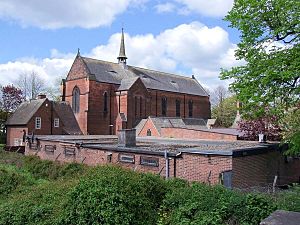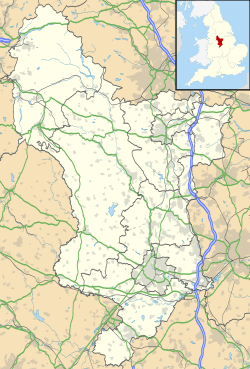St Osmund's Church, Derby facts for kids
Quick facts for kids St Osmund’s Church, Derby |
|
|---|---|

St Osmund’s Church, Derby
|
|
| 52°54′14.52″N 1°26′44.51″W / 52.9040333°N 1.4456972°W | |
| Location | Derby, Derbyshire |
| Country | England |
| Denomination | Church of England |
| History | |
| Dedication | St Osmund |
| Consecrated | 2 December 1905 |
| Architecture | |
| Heritage designation | Grade II listed |
| Architect(s) | Percy Heylyn Currey |
| Groundbreaking | 6 August 1904 |
| Specifications | |
| Length | 110 feet (34 m) |
| Width | 25 feet (7.6 m) |
| Height | 55 feet (17 m) |
| Administration | |
| Parish | St Andrew with St Osmund Derby |
| Deanery | Melbourne |
| Archdeaconry | Derby |
| Diocese | Diocese of Derby |
St Osmund's Church in Derby, Derbyshire, is a special building. It is a Church of England parish church. This means it serves the local community. It is also a Grade II listed building. This listing means it is an important historical building. It is protected to make sure it lasts for a long time.
Contents
Building History
How the Church Was Built
The first stone for St Osmund's Church was put in place on August 6, 1904. This is called the foundation stone. The church was designed by two architects. Their names were Percy Heylyn Currey and Charles Clayton Thompson. A builder named Mr. R. Weston from Derby constructed the church.
The church was built using special materials. It has bricks from Leicestershire. It also has stone from Matlock. This stone was used for the decorative parts. The church was officially opened on December 2, 1905. The Bishop of Southwell led the special ceremony.
Joining Parishes
In 1971, another church nearby, St Andrew's Church, Derby, was taken down. After that, the two church areas, or parishes, joined together. Now, St Osmund's Church serves both communities.
The Church Organ
A Musical Instrument
Churches often have large musical instruments called organs. St Osmund's Church had an organ installed by a company called Bishop and Son. This organ helped lead the singing during services.
A New Organ for the Church
In 2013, the church got a different organ. This organ was built in 1875 by a company called Hunter. It had been in two other churches before coming to St Osmund's. First, it was in Christ Church, Brixton Road. Then, it moved to Queen's Hall Methodist Church in Derby. You can find out more about this organ on the National Pipe Organ Register. This register keeps details about many organs.
See also
- Listed buildings in Alvaston


